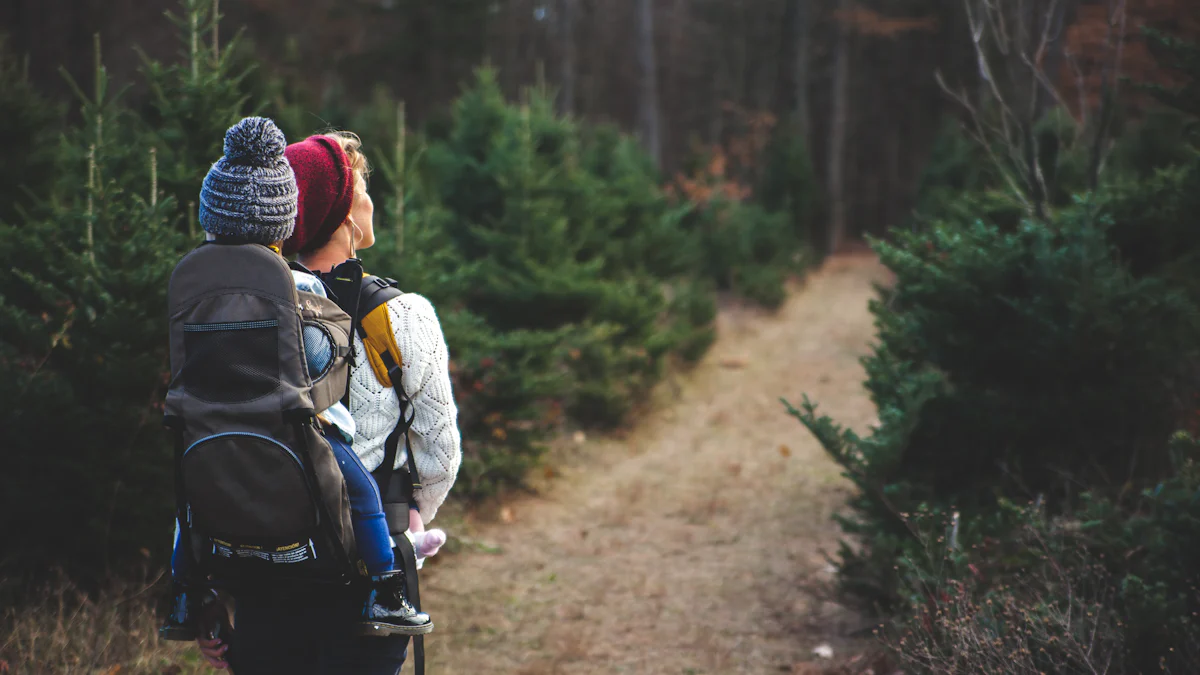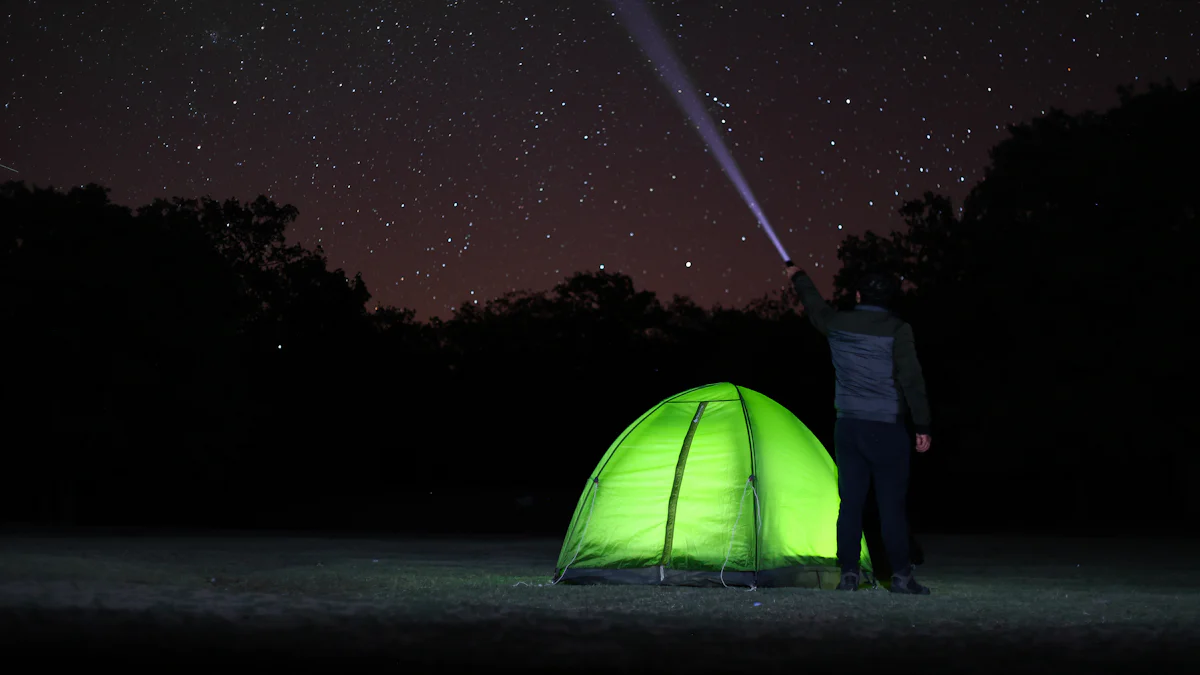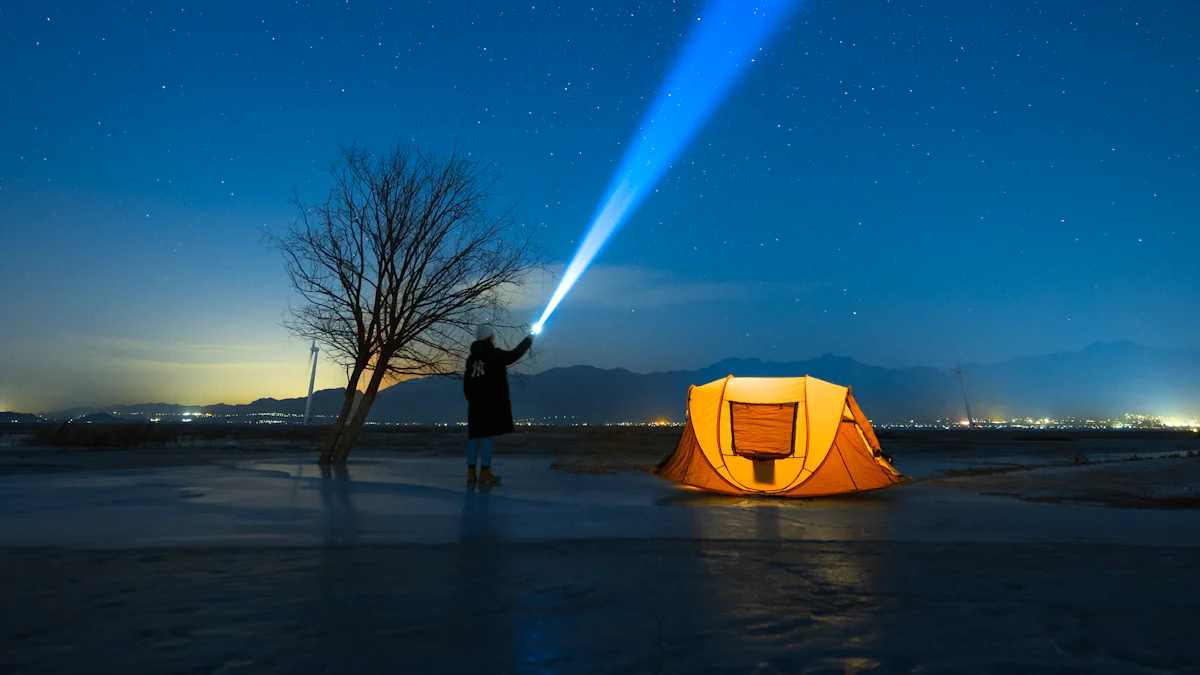Choosing a Flashlight for Backpacking and Hiking

When you're out on the trail, having the right flashlight can make all the difference. It’s not just about seeing in the dark—it’s about staying safe and prepared. A good flashlight keeps you on track, helps you navigate tricky terrain, and even signals for help in emergencies. Features like adjustable brightness let you save battery life while providing just the right amount of light for tasks like reading a map. Lightweight designs and compact sizes make carrying one easy, especially when every ounce matters. Plus, water resistance ensures your flashlight works even in wet conditions. Whether you're hiking at night or caught in unexpected weather, the right flashlight choices can give you peace of mind.
Key Takeaways
Pick a flashlight with the right brightness for hiking. For easy trails, 100-150 lumens works well. For rough paths, choose 200-300 lumens.
Think about how far and wide the light shines. The beam should reach 50-100 meters to see obstacles early. A wide beam helps when hiking with others.
Choose a flashlight that is small and light. A lighter one is easier to carry on long hikes. Compact flashlights are portable but still bright.
Make sure it is tough and water-resistant. An IPX4 rating protects against rain. Higher ratings are better for very wet places.
Use flashlights with adjustable brightness and special modes. Red light or SOS modes can help in emergencies and make hiking safer.
Brightness and Beam Type for Hiking

Understanding Lumens in Flashlight Choices
What are lumens, and why do they matter for hiking?
When choosing a flashlight for hiking, you’ll often see the term "lumens" mentioned. But what does it mean? Lumens measure the total amount of visible light a flashlight produces. In simpler terms, the higher the lumens, the brighter the light. For hiking, this matters because you need enough brightness to see clearly without straining your eyes. Whether you're navigating a rocky trail or setting up camp in the dark, the right lumen level ensures you can see your surroundings and stay safe.
Recommended lumen range for backpacking and hiking
Not all hiking situations require the same level of brightness. Here’s a quick guide to help you decide:
For well-marked trails, 100-150 lumens work perfectly.
If you're tackling rugged or unmarked terrain, aim for 200-300 lumens.
Night hiking? Go for at least 200 lumens to ensure safety and visibility.
Choosing the right lumen range depends on where and when you’re hiking. Always consider the environment and your specific needs.
Beam Distance and Coverage for Trails
How far should your flashlight beam reach for safety?
Beam distance refers to how far the light from your flashlight can reach. For hiking, this is crucial. You want a flashlight that can illuminate the trail ahead, especially in low-light conditions. A beam distance of at least 50-100 meters is ideal for most hiking activities. This range allows you to spot obstacles, wildlife, or changes in terrain well in advance, giving you time to react.
The importance of beam width for different hiking activities
Beam width is just as important as beam distance. A wider beam helps you see more of your surroundings, which is great for group hikes or setting up camp. On the other hand, a narrower beam focuses the light on a specific area, making it better for spotting distant objects or navigating tricky paths. Think about your hiking style and choose a flashlight that matches your needs.
Flood vs. Spot Beams in Flashlight Choices
When to choose a flood beam for wide coverage
Flood beam flashlights are perfect for group hiking or campsite activities. They spread light over a wide area, making it easier for everyone to see their surroundings. This type of beam is especially helpful when you’re cooking, setting up tents, or just hanging out with your group. It ensures everyone stays safe and avoids potential hazards.
When to opt for a spot beam for long-distance visibility
If you’re hiking solo or exploring unmarked trails, a spot beam is your best friend. It focuses the light into a narrow, intense beam, allowing you to see far ahead. This is ideal for spotting trail markers, wildlife, or obstacles in the distance. Spot beams are also great for night hikes when you need to focus on what’s directly in front of you.
Weight and Portability in the Best Ultralight Flashlights

Lightweight Designs for Backpacking
Why weight matters for backpacking and hiking
When you're out on the trail, every ounce counts. Carrying a heavy flashlight can quickly become a burden, especially on long hikes. A lightweight flashlight makes it easier to move freely and reduces strain on your back and shoulders. This is particularly important when you're navigating uneven terrain or climbing steep paths. A lighter load means you can focus on enjoying the hike instead of worrying about your gear.
Balancing weight with functionality in ultralight flashlights
Finding the right balance between weight and functionality is key. You want a flashlight that’s light enough to carry but still durable and reliable. Many of the best ultralight flashlights weigh less than an ounce without batteries, as shown in the table below:
Flashlight Weight (oz) |
|---|
0.88 (with battery) |
0.60 (without battery) |
0.35 (without battery) |
0.88 (with battery) |
0.42 (without battery) |
Look for models made from materials like aluminum or reinforced plastic. These materials keep the flashlight strong without adding unnecessary weight. Features like waterproofing and impact resistance also ensure your flashlight can handle outdoor challenges without compromising its portability.
Compact vs. Full-Sized Flashlights
Benefits of compact flashlights for portability
Compact flashlights are a hiker’s best friend. They’re small enough to fit in your pocket or clip onto your backpack, making them easy to carry. Despite their size, many compact models offer impressive brightness and long battery life. You’ll barely notice them in your gear, but they’ll be there when you need them most. Plus, their lightweight design ensures you won’t feel weighed down, even on multi-day trips.
When a full-sized flashlight might be a better choice for hiking
While compact flashlights are great for portability, full-sized models have their own advantages. They’re bulkier, but they often provide stronger beams and longer battery life. If you’re heading into remote areas or need a flashlight for heavy-duty tasks, a full-sized option might be worth the extra weight. These flashlights are built for durability and can handle tough conditions, making them a reliable choice for challenging hikes.
Battery Life and Power Source for Backpacking
Rechargeable vs. Disposable Batteries
Pros and cons of rechargeable flashlights for backpacking
Rechargeable flashlights are a popular choice for backpacking. They’re convenient and eco-friendly, especially when paired with a built-in USB rechargeable feature. You can recharge them using portable power banks or solar panels, making them ideal for multi-day backpacking trips. Plus, they reduce waste since you’re not constantly throwing away used batteries. However, they do have some downsides. Tactical flashlights with rechargeable batteries often have shorter runtime when used at high brightness levels. If you forget to recharge before heading out, you might find yourself in the dark.
Pros and cons of disposable batteries for hiking trips
Flashlights with disposable batteries offer a reliable backup option. You can carry extra batteries and replace them on the go, ensuring continuous use. This is especially helpful if you’re hiking in remote areas without access to power. On the flip side, disposable batteries can be harmful to the environment if not disposed of properly. Recycling them is crucial to prevent toxic chemicals from polluting the earth. While they’re convenient, they’re not the most sustainable choice for frequent hikers.
Battery Life Considerations for Long Hikes
How to estimate battery life for extended backpacking trips
Understanding your flashlight’s runtime is essential for long hikes. Check the manufacturer’s specifications to see how long the battery lasts at different brightness levels. For example, a flashlight like the Fenix E12 offers excellent battery life when not used at maximum brightness. If you plan to use high lumens, expect a shorter runtime. Always calculate how many hours of light you’ll need each day and bring extra batteries or a rechargeable option to stay prepared.
Tips for conserving battery power during outdoor use
You can extend your flashlight’s battery life with a few simple tricks. Use lower brightness settings whenever possible. Switch to a red light mode if your flashlight has one—it consumes less power and preserves night vision. Turn off the light when you don’t need it, and avoid using high-lumen settings unless absolutely necessary. These small adjustments can make a big difference during long backpacking trips.
Solar and Hand-Crank Flashlight Options
When alternative power sources are useful for hiking
Solar and hand-crank flashlights are excellent for emergencies. They don’t rely on traditional batteries, so you’ll always have a light source as long as you have sunlight or the ability to crank. These options are great for eco-conscious hikers or those venturing into areas without electricity. They’re also lightweight, making them easy to pack.
Limitations of solar and hand-crank flashlights
While these flashlights are handy, they’re not perfect. Solar-powered models depend on sunlight, which can be unreliable in cloudy weather or dense forests. Hand-crank flashlights require physical effort, which can be tiring if you need light for extended periods. Additionally, their brightness and runtime are often limited compared to traditional flashlights. Consider these as backup options rather than your primary light source.
Durability and Weather Resistance in Flashlight Choices
Water Resistance Ratings for Hiking Flashlights
Understanding IPX ratings for water resistance
When you're out in the wild, your flashlight needs to handle whatever nature throws at it. That’s where IPX ratings come in. These ratings measure how well a flashlight can resist water under specific conditions. For example, an IPX4 rating means the flashlight can handle splashes from any direction, while an IPX7 rating ensures it can survive being submerged in water up to one meter for 30 minutes. Knowing these ratings helps you pick a flashlight that won’t fail in rain, snow, or even during a stream crossing.
Recommended water resistance levels for outdoor use
For hiking and backpacking, you’ll want a flashlight with at least an IPX4 rating. This level protects against rain and light splashes, which is usually enough for most trails. However, if you’re heading into wetter environments or unpredictable weather, consider an IPX7 or IPX8-rated flashlight. These higher ratings ensure your light stays functional even in heavy downpours or accidental submersion. Waterproof flashlights not only keep shining in tough conditions but also provide peace of mind during emergencies.
Rugged Construction for Backpacking
Materials that enhance flashlight durability
Durability is key when you’re relying on your flashlight in the backcountry. Look for models made from materials like aircraft-grade aluminum or reinforced plastic. These materials are lightweight yet tough enough to handle rough handling. Aluminum flashlights, in particular, resist corrosion and scratches, making them ideal for long-term outdoor use. A durable flashlight ensures you won’t have to worry about it breaking when you need it most.
Shock resistance and drop-proof designs for hiking
Hiking trails can be unforgiving, and your gear needs to keep up. Flashlights with shock-resistant and drop-proof designs are built to survive accidental falls. Many models feature rubberized edges or reinforced frames to absorb impact. This is especially important since common durability issues include weak seals and fragile construction. A rugged flashlight can handle bumps, drops, and other mishaps, ensuring it stays reliable throughout your adventure.
Tip: Always check the manufacturer’s specifications for drop-test ratings. A flashlight tested for drops from at least one meter is a solid choice for hiking.
Additional Features in the Best Ultralight Flashlights
Red Light Modes for Night Hiking
Benefits of red light for night vision during hiking
Red light is a game-changer when hiking at night. It preserves your night vision by minimizing the impact on the rods in your eyes, which are responsible for seeing in low-light conditions. This means you can switch on your flashlight without losing your ability to see in the dark. Red light also keeps your peripheral vision sharp, making it easier to spot obstacles or navigate tricky trails. If you’re reading a map, red light is especially helpful. The center of your eye is sensitive to red light, so you can read clearly without straining your vision.
When to use red light modes during outdoor activities
You’ll find red light modes most useful during activities that require subtle illumination. Use it when setting up camp after dark or when you’re hiking with a group and don’t want to disturb others. It’s also perfect for stargazing since it won’t interfere with your ability to see the night sky. Anytime you need light but want to avoid startling wildlife or ruining your night vision, red light is the way to go.
Strobe and SOS Functions for Safety
How strobe functions can enhance safety during hiking
A strobe function can be a lifesaver on the trail. It’s highly visible and can grab attention quickly, making it ideal for signaling your location in emergencies. If you’re hiking in areas with heavy fog or low visibility, the flashing light cuts through the haze, ensuring you’re seen by others. It’s also a great deterrent for wildlife, as the sudden bursts of light can scare off animals.
Using SOS modes in emergencies while backpacking
The SOS mode is another essential feature for safety. It flashes a universal distress signal, which can help rescuers locate you if you’re lost or injured. This mode is especially useful in remote areas where cell service is unreliable. Having a flashlight with an SOS function gives you peace of mind, knowing you have a reliable way to call for help.
Adjustable Settings for Versatility
Importance of brightness adjustability in flashlights
Brightness settings are crucial for conserving battery life and adapting to different tasks. Lower settings work well for close-up activities like reading maps or setting up a tent, while higher settings provide the light output needed for navigating dark trails. Adjusting the brightness ensures you get the most out of your flashlight’s output and runtime.
Other customizable features to look for in hiking flashlights
Look for flashlights with adjustable beams. Switching between a wide flood beam and a focused spot beam gives you flexibility for various activities. Flood beams are great for illuminating campsites, while spot beams excel at long-range visibility. Some models even let you toggle between modes like red light or strobe, adding to their versatility. Features like USB charging ports also make it easier to keep your flashlight powered during extended trips.
Choosing the right flashlight for backpacking and hiking means finding the perfect balance between brightness, weight, battery life, durability, and features. For short hikes, you might prefer something lightweight like the Nitecore NU25. It’s compact and offers just enough light for most tasks. If durability is your priority, the Fenix PD36R stands out with its rugged build and excellent weather resistance. For longer trips, the Olight Baton 3 Pro Max provides reliable battery life, ensuring you’re never left in the dark.
When selecting a flashlight, think about your specific needs. Do you need a red light mode for night hiking? Or perhaps a flashlight with an SOS function for emergencies? Consider factors like beam type, portability, and weather resistance to make the best choice. Brands like Fenix, Black Diamond, and Streamlight are trusted options for outdoor adventures. Remember, the right flashlight isn’t just a tool—it’s your companion for safety and convenience on the trail.
FAQ
What is the best flashlight for ultralight backpacking?
The best flashlight for ultralight backpacking is compact, lightweight, and durable. Models like the Nitecore NU25 weigh less than an ounce and still provide excellent brightness. Look for options with rechargeable batteries to save weight and space in your pack.
How do I know if a flashlight is waterproof?
Check the IPX rating on the flashlight. An IPX4 rating means it’s splash-proof, while IPX7 or IPX8 ensures it can handle submersion. Always choose a rating that matches the conditions you’ll face on your hike.
Should I carry a backup flashlight?
Yes, carrying a backup flashlight or headlamp is smart. Batteries can die, or your primary flashlight might fail. A small, lightweight backup ensures you’re never left in the dark during your adventure.
Can I use a headlamp instead of a flashlight?
Absolutely! Headlamps are hands-free and great for hiking or setting up camp. They’re lightweight and provide good visibility. However, flashlights often offer more beam options and brightness levels, so it depends on your needs.
How do I conserve battery life on long hikes?
Use lower brightness settings whenever possible. Turn off the flashlight when you don’t need it. If your flashlight has a red light mode, use it—it consumes less power and preserves night vision. Carry extra batteries or a power bank for emergencies.
See Also
Selecting The Best Rechargeable Flashlight For Hiking Adventures
Essential Tips For Picking The Perfect Flashlight For Hiking
Guidelines For Selecting The Ideal Flashlight For Camping
Steps To Find The Perfect Headlamp Flashlight For You
A Beginner's Guide To Selecting The Right Hunting Flashlight
